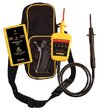- Joined
- 27 Jan 2008
- Messages
- 24,086
- Reaction score
- 2,742
- Location
- Llanfair Caereinion, Nr Welshpool
- Country

We see the testers,
 and we, or at least I, have been forced to use them, idea is can't be switched off, so not battery powered, and no switches, and the proving unit will show if it will not detect 50 volts AC or 75 volt DC.
and we, or at least I, have been forced to use them, idea is can't be switched off, so not battery powered, and no switches, and the proving unit will show if it will not detect 50 volts AC or 75 volt DC.
But most of the proving units I have used, were well over 50 volts AC or 75 volt DC, so they did not prove the tester will detect over extra low voltage. About a good as a chocolate fireguard if they will not prove the tester will work on low voltage.
So if the proving unit is no good, is there any point using a tester with can't be switched, has no batteries, etc? Or if the proving unit is useless, may we just as well use our multi-meter?
I have two multi-meters I use on a regular basis, the yellow on will only measure AC current, the red one will do AC and DC current, and has non-contact voltage testing option, so between the two, can do most the testing I need, I have got a martindale tester as shown, and I have a battery pack with 230 volt AC output so could use it as proving unit, but why bother, using a neon screwdriver should an error be made, likely that will highlight error.
the yellow on will only measure AC current, the red one will do AC and DC current, and has non-contact voltage testing option, so between the two, can do most the testing I need, I have got a martindale tester as shown, and I have a battery pack with 230 volt AC output so could use it as proving unit, but why bother, using a neon screwdriver should an error be made, likely that will highlight error.
If I select wrong range it may damage the meter, but it will not damage me, I can't cause a short circuit with the meters even if on the wrong range.
So in real terms other than to satisfy some jobs worth safety officer, with low voltage supplies, is there really any need for the special proving for dead testers? I am sure, like the doctor's stethoscope around his neck, the volt tester around one's neck is more a badge of office than a tester which is really required.
So what does the team think?
 and we, or at least I, have been forced to use them, idea is can't be switched off, so not battery powered, and no switches, and the proving unit will show if it will not detect 50 volts AC or 75 volt DC.
and we, or at least I, have been forced to use them, idea is can't be switched off, so not battery powered, and no switches, and the proving unit will show if it will not detect 50 volts AC or 75 volt DC.But most of the proving units I have used, were well over 50 volts AC or 75 volt DC, so they did not prove the tester will detect over extra low voltage. About a good as a chocolate fireguard if they will not prove the tester will work on low voltage.
So if the proving unit is no good, is there any point using a tester with can't be switched, has no batteries, etc? Or if the proving unit is useless, may we just as well use our multi-meter?
I have two multi-meters I use on a regular basis,
 the yellow on will only measure AC current, the red one will do AC and DC current, and has non-contact voltage testing option, so between the two, can do most the testing I need, I have got a martindale tester as shown, and I have a battery pack with 230 volt AC output so could use it as proving unit, but why bother, using a neon screwdriver should an error be made, likely that will highlight error.
the yellow on will only measure AC current, the red one will do AC and DC current, and has non-contact voltage testing option, so between the two, can do most the testing I need, I have got a martindale tester as shown, and I have a battery pack with 230 volt AC output so could use it as proving unit, but why bother, using a neon screwdriver should an error be made, likely that will highlight error.If I select wrong range it may damage the meter, but it will not damage me, I can't cause a short circuit with the meters even if on the wrong range.
So in real terms other than to satisfy some jobs worth safety officer, with low voltage supplies, is there really any need for the special proving for dead testers? I am sure, like the doctor's stethoscope around his neck, the volt tester around one's neck is more a badge of office than a tester which is really required.
So what does the team think?



